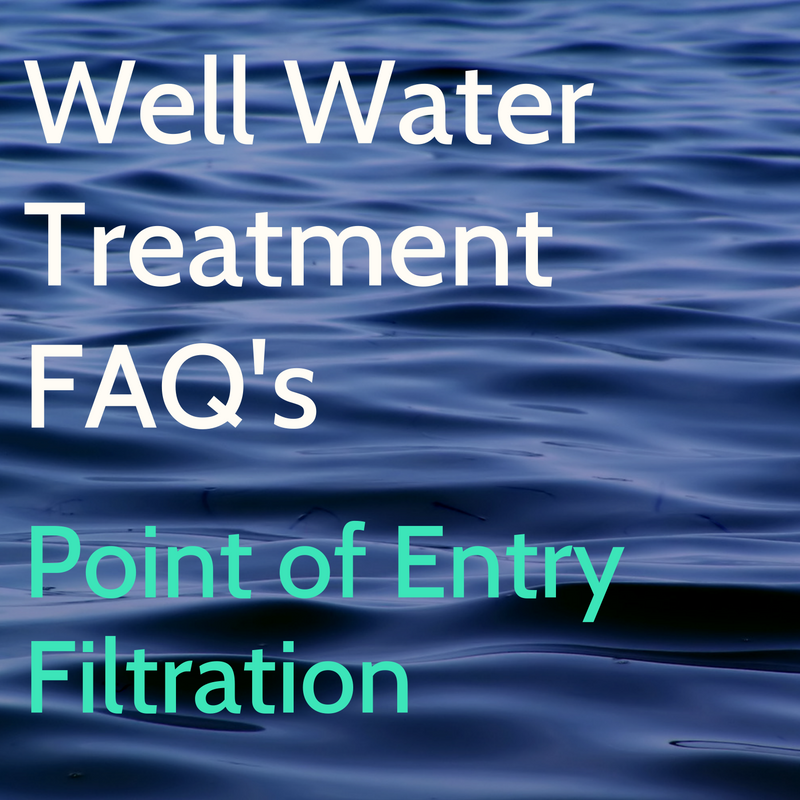All About Water Treatment Systems: Point of Entry Filtration
As we all strive to live healthier more sustainable lives, clean water is one cornerstone of a healthier lifestyle. If you receive your water from a private well or even a municipal water system, there are many water filtration systems that can assure that the water coming into your home is free from all contaminants like lead, arsenic, radon, heavy metals, and organic and manmade compounds.
While there are a wide variety of treatment systems available, there are only two different “delivery systems” available. Point-of- Use (PoU) systems are devices that treat water and deliver it to a single source, for example, a distillation system with a tap at the kitchen sink that delivers water for drinking and cooking.
The second type of delivery system is called a Point-of-Entry system and it is placed on the main water line before it enters your home's plumbing system. POE is also known as “whole house” filtration because it treats your water prior to it entering your home. This means that every outlet dispenses clean, contaminant free, pre-treated water.
Let's answer some frequently asked questions about the benefits of point-of-entry filtration systems.
What Exactly is a Point-of-Entry Water Treatment System?
Point-of-entry or whole house systems are exactly what the name implies. The system is installed at the point where water enters your home's plumbing and pre-treats your water at the source. It is designed to remove contaminants in water intended for drinking, cooking showering, washing clothes and dishes, brushing teeth and flushing toilets
What are the benefits of point-of-entry filtration?
PoE filtration provides a whole host of tangible benefits for the health and safety of you and your family. Along with providing clean water for every purpose in your home, it can remove potentially harmful chemicals like chlorine and radon before they can enter your home's air through aeration in the shower. This means not only clean water, but cleaner air which can help to alleviate the symptoms of allergies and asthma. Removing chlorine before it enters your home means that it's not longer embedded in clothing making clothes cleaner and chlorine residue free. No chlorine also means cleaner dishes and reduced soap scum.
Whole house filtration greatly improves the taste and healthfulness of your drinking water and protects against the carcinogenic effects of drinking (and inhaling) chlorine, radon, arsenic and other dangerous chemicals and organisms. Finally, whole house filtration systems are the last line of defense when a municipal, or sanitation system breaks down.
What are the different types of point-of-entry systems available?
There are many options of PoE systems available. Depending on your needs and the levels and types of contaminants present there are systems designed to remove specific contaminants such as arsenic, heavy metals, excess minerals and organic materials. Here are a few options:
Ion exchange systems – Uses resins to remove contaminants. The selection and choice of resins is dependent upon the particular contaminant needing removal and the level it must be reduced.
Cation exchange water softening – Commonly used for removing excess minerals and water softening, cation exchange systems use sulfonated polystyrene balls to remove hardness ions and replace them with softer ions like sodium.
Filtration systems - Filtration systems are best for removing organic and inorganic material like microbiological and virus contaminants as well as particulates like sand, rust and salt. Filtration is accomplished through various means like fine physical barriers, chemicals or other media like activated charcoal. The type of filter is dependent upon the contaminants that are present.
Electrochemical systems – EC uses electricity and ionization membranes to remove contaminants like chlorides, sulfates, nitrates, nitrites, fluorides, magnesium, sodium, lead and uranium.
What about maintenance?
Point-of-entry systems do require periodic maintenance like filter changes and cleanings. The extent, frequency, and cost of maintenance and operation varies depending upon the type of system used. Your well water professional can help you to understand the installation and ongoing costs of any PoE system.
How do I know which point-of-entry system is right for me?
The first step is to contact your water professional and arrange to have your water tested. They will then analyze the results and determine which type of system is right for you. Your well water professional can then explain your options and all of the costs associated with your purchase, installation and ongoing maintenance for your system.
Point-of-entry water treatment systems are an effective choice to reduce or stop contaminants from entering your home. It's important to test and analyze your water prior to selecting and installing any system. Combining a point-of-entry system with point-of-use systems like faucet filtration or distillation systems can ensure that your family will enjoy a healthy, safe supply of water in your home.


